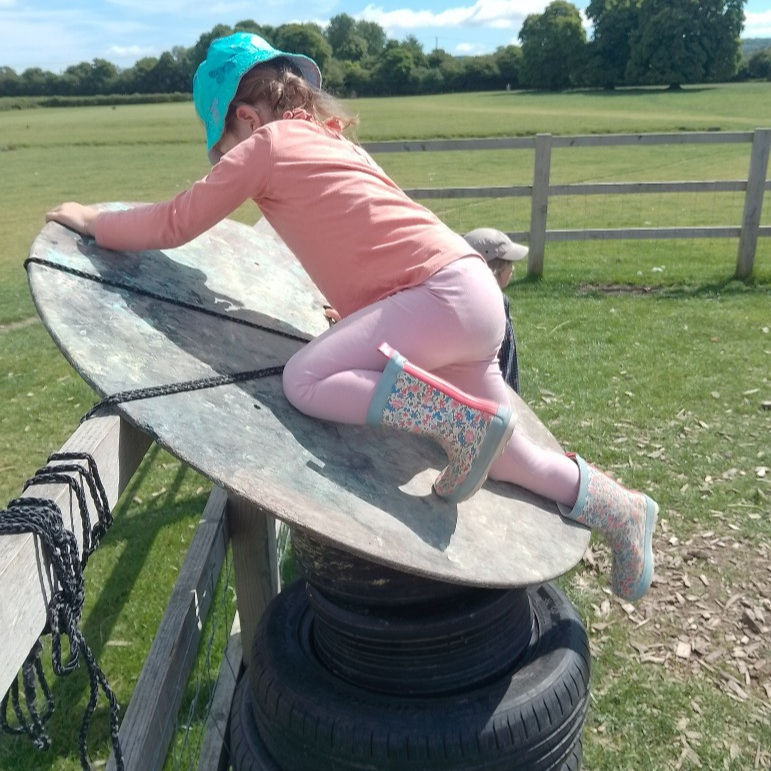Embracing the Thrill: The Value and Importance of Risky Play
- Georgina Adams

- Jun 18
- 3 min read
At our forest school nursery, we believe in the power of play – especially the kind that makes your heartbeat a little faster! We understand that the term "risky play" might raise eyebrows, but we want to assure you that it's a vital part of your child's development. This document aims to shed light on why we value and encourage risky play in our natural environment.

What is Risky Play?
Risky play isn't about reckless abandon. It's about children
exploring their limits, testing their abilities, and learning to
manage challenges within a safe and supportive environment.
It encompasses activities that involve:
Height: Climbing trees, balancing on logs.
Speed: Running, sliding, swinging.
Tools: Using tools like saws, hammers, and gardening tools (under close supervision).
Rough-and-tumble: Wrestling, play fighting.
Elements: using fire to cook food and keep warm, understanding and respecting the elements; water, wind and fire and exploring challenging terrain.
Disappearance/Exploration: Exploring the forest, venturing into "hidden" spaces where children can create their own ‘dens’ and play areas

Why is Risky Play Important?
Physical development: Risky play builds gross motor skills, coordination, balance, and spatial awareness. Climbing, jumping, and navigating uneven terrain has far reaching benefits including strengthening muscles, improving physical dexterity and building bone density: ‘a key factor in life expectancy and intrinsically important for our adult health’ (1)
Cognitive development: Children learn to assess risks, problem-solve, and make
decisions. They develop critical thinking skills as they figure out how to climb a tree
safely or build a sturdy den.
Emotional development: Risky play fosters resilience, self-confidence, and
emotional regulation. Overcoming challenges and managing fear builds a sense of
accomplishment and empowers children to face future obstacles.
Social development: Collaborative risky play encourages teamwork, communication, and negotiation. Children learn to work together, share ideas, and (support each other) collaborate in safe decision making.
Risk assessment skills: By engaging in managed risk, children learn to accurately
assess situations and make informed decisions. This is a crucial life skill that helps
them navigate the world safely.
Connection with nature: Forest school provides a rich environment for exploration
and discovery. Risky play in nature fosters a sense of awe and wonder, a deep
connection, and respect for the natural world
Building resilience: When children are allowed to test their limits, and sometimes
experience minor mishaps, they learn that they can recover and keep trying. This
builds resilience, a key component of emotional wellbeing.

Our Role in Supporting Risky Play:
Careful observation and dynamic assessment: We closely observe children's play, and, on an ongoing basis, we dynamically assess potential risks, and take steps to ensure a safe environment.
Providing appropriate challenges: We offer developmentally appropriate
challenges that encourage children to safely test their boundaries while minimizing potential harm.
Supervision and guidance: Due to our high adult to child ratio, we are more
attuned to children's individual capacities for safe risk taking. We adjust our level of
support and guidance to suit children's individual developmental stages. We provide guidance and support, allowing children to take calculated risks while ensuring their safety.
Tool safety education: If tools are used, we provide thorough instruction and supervision.
Creating a safe environment: We ensure the environment is as safe as possible by checking for hazards and creating designated play areas.
Open communication: We maintain open communication with parents, addressing any concerns and providing information about our approach to risky play.
(We carefully assess risks, provide appropriate supervision, and create a supportive environment where children can learn and grow.) From experience, we rarely need to apply first aid as a result of risky play. As with any setting, there are odd occasions when we have been required to administer first aid, e.g.when a slip, trip or fall has happened. ( as it could in any setting).
The Value of Letting Go
Allowing children to take calculated risks is an act of trust. It communicates that we believe in their abilities and empowers them to become confident, capable individuals. By embracing risky play, we are giving our children the tools they need to thrive in a complex and ever-changing world.
We encourage you to discuss any questions or concerns you may have with the team. We are committed to working together to provide your child with a rich and fulfilling learning experience.



Comments